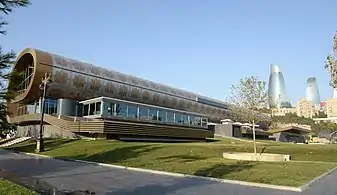Azerbaijani rug
Azerbaijani rugs (Azerbaijani: Azərbaycan xalçaları) are a product of Azerbaijan, an ancient center of carpet weaving. The Azerbaijani rug is a traditional handmade textile of various sizes, with dense texture and a pile or pile-less surface, whose patterns are characteristic of Azerbaijan's many carpet-making regions. Traditionally, since ancient times the carpets were used in Azerbaijan to cover floors, decorate interior walls, sofas, chairs, beds and tables.[1]
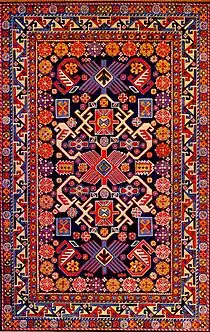

Carpet making is a family tradition transferred orally and through practice, with carpet making and rug making being predominantly a women's occupation. In the past, every young girl had to learn the art of weaving carpets, and the carpets she wove became a part of her dowry. In the case of a newly married son, it was his mother who wove a large rug for his new household. Starting a new carpet meant a feast, but the completion of a rug meant an even greater celebration for the family. In the old days, finished carpets were laid out in front of the house so that passers-by with the weight of their feet could make them even tighter than they had already been knotted. For the traditional process of carpet and rug making, men sheared the sheep for the wool in the spring and autumn, while women collected dyestuffs and spin and dye yarn in the spring, summer and autumn. Azerbaijani carpets are classified under four large regional groups, i.e. Quba-Shirvan, Ganja-Kazakh, Karabakh, and Baku.[1]
In November 2010 the Azerbaijani carpet was proclaimed a Masterpiece of Intangible Heritage by UNESCO.[1][2]
History


Since ancient times, Azerbaijan has been known as a center of a large variety of crafts. The archeological dig on the territory of Azerbaijan testifies to the well-developed agriculture, stock raising, metal working and ceramics, and last but not least carpet-weaving that date as far back as to the 2nd millennium BC.
The results of the archeological digging in Azerbaijan validate the antiquity of the carpet weaving traditions on this land. The Gultapin excavations discovered carpet weaving tools which date back to the 4th–3rd millennium BC. For many centuries during the historical existence of Azerbaijan, both settled and nomadic ways of life were of importance.
The carpet making was born in rural huts and with time ranked among the most essential arts. It was highly valued by the heads of states, and the gifted weavers were glorified by the greatest poets. The carpet history is assumed to be divided into the following four main periods:
- I period – the early stage of the carpet development. The carpet ware is very simple, without any motifs and patterns. The first palas and djedjims appear.
- II period – introduction of the kilim weaving practice by the intricate threading technique.
- III period – weaving of shadda, verni, sumakh, zili. The period of simple and complex whipping techniques.
- IV period – introduction of the knotted pile weaving. Both from the technical and artistic standpoints this stage can be considered the acme of the carpet making.
Flat-weave carpets
Shadda
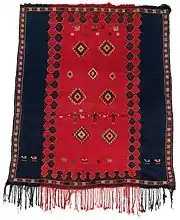
Shadda is a flat weave carpet, made primarily in Nakhchivan, Agdam, Gubadly, Agjabedi. The artistic composition of shadda made by complicated whipping, as well as its constituents have a complex form. Early in the 20th century the oldest weavers and carpet experts called this type of carpets “shadra’ or “shatra”. The word “shadda” is a distorted form of “shatranj” and “shadvard”. Shadda comes in a number of varieties, each having a specific technique such as monochrome, checkered or subject. Monochrome shadda are made by the simple interweaving technique. Shadda with a checkered pattern is based on the palas and jejim principle. The same technique is used to make subject-based shadda. The subject shadda “Davali” are famous all over the world. They use practically one and the same subject with the composition being almost invariable: the camelcade moving along the carpet field from left to right, along a few horizontal rows, and each string running into a figure of a sarvan on foot. The humans and animals are set off against the dark-red field, its color is smooth and hot.

Verni
The most widely spread type of the flat-weave carpet is “verni”. Perhaps none of the flat-weave carpets can boast such a monumental pattern and harmonious clarity as the “verni” made only in Azerbaijan. The technical perfection and utmost emotionality of these carpets is a sort of acme of the Azerbaijani carpet art. Sample “verni” displayed in various museums throughout the world presents the outstanding monument of the richest heritage of the Azerbaijani folk art in which we by right take pride. Among the “verni” centers were Agjabedi, Barda, Agdam, Nakhchivan. The key décor feature, which is intrinsical to every ”verni” is the S-element. Its shape varies, it may resemble both figure 5 and letter S. This element means “dragon” among the nomads and “water” among the village people. Based on the stories told by the oldest Azerbaijani weavers with nomadic roots, a dragon featuring carpet would protect the family from foul weather. In Taoism, a dragon is associated with spring. The Tibet pantheon considers dragon as a good deity, a master of chiefs. If the S-element takes up the whole of the carpet space, it would be viewed as an image of a dragon itself rather than a dragon symbol. This element has been known to the local weaver for centuries and is characterized by an ability to come alive through embodiment in a specific image and to symbolize the good and happiness.
Jejim
Jejims are woven on simple horizontal looms by narrow stripes 30–35 cm wide and 15–10 cm long. The resulting product is a cloth to be used as a wall carpet, a bedding coverlet, or curtains. The width of a jejim matches the distance between the weaver's feet as in the process of weaving the whole width of the cloth should pass through the weaver's feet. The ornamental décor of jejims is diverse and rich. Various vertical stripes that decorate jejims are spectacular, colorful and decorative. They are often decorated by stylized images of utensils (comb, thread, candlesticks) and geometrical elements. Up to the mid 20th century delicate jejims were used to make garments both for men and women. The major jejim production centers are Barda, Nakhchivan, Zangilan, Shusha, Shamakha.
Zilli
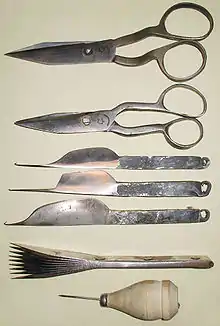
“Zilli” are characterized by stylized forms of animals and vegetal elements. In terms of their composition and pattern, the Azerbaijani zillis are very diverse. They feature a plastic flexibility of the pattern and emotional expressiveness. The ornamental decoration is marked by images of large elements in the shape of big lozenges, paired horns, various stylized elements. There are “zillis” with a variety of compositions, which differed by peculiar vegetal ornamental patterns and overall rich colors. The key element in such compositions lies in the recurring alternation of colors along the horizontal pt vertical lines, which form an "energetic" rhythm. As to their technical and artistic qualities, “zillis” are rich in moving images of stylized birds, elaborated “butas” and other elements. “Zilli” were influenced by the tendency to fill in the space by various motifs, each being repeated in the field according to its individual layout, and the overall result resembles a fancy garden with a rich and fairy-tale flora.
Kilim
Kilim is the most widespread type of flat-woven carpets. They are made by passing the weft through the warp using the technique of compound interweaving. Kilim is characterized by a slot-like gap (opening) around the geometrical patterns. These openings impart a lace effect the kilim. The technique of kilim weaving predetermines the pattern shapes in the form of a lozenge, triangle, trapezium.[3] Nearly all the vegetal elements, images of animals, birds and humans are geometrized in kilims. Kilims of different regions are distinguished by their composition, pattern, and colors. In terms of their technical peculiarities, kilims can be classified into five major groups based on the area of production: Kazakh, Karabakh, Absheron, and Shirvan kilims. They are all characterized by a balanced composition, contrasting colors and clear symmetry. The pattern is traditional, in the form of large and small lozenge and hook-like elements, which are rather expressive and dramatic.
Sumakh
The “Sumakh” carpets present one of the interesting types of flat-weave carpets, which have become widely spread and recognized over the last few centuries. Beginning with the 18th century “Sumakhs” have been made in the Quba nd Gusary districts.[4]“Sumakhs” were created much later than other types of flat-woven carpets. In the early stage of their development they, might have had their own individual composition, but the “Sumakhs” of the 18th–20th centuries reproduce the compositions and patterns copied from the pile carpets made in Shirvan, Quba, Karabakh and Ganja. The technological peculiarity of “Sumakh” lies in their rich composition and colors. The diverse stylized vegetal motifs, various geometrical elements such as large hexahedral, square, rhomboid medallions impart festive beauty to “Sumakh”. The traditional pattern includes the minor edge with a wave-like pattern, which is called “dolan-gach” (pass around – run away). It is used basically in all “Sumakh” type carpets.
Palas
Palas is one of the widely spread flat-weave carpets. The palas weaving process consists in passing the weft through the warp by a simple technique. The weavers decorate the palas by traditional patterns in the form of horizontal stripes commonly used throughout Azerbaijan. But every individual weavers had their own choice of composition and colors.[5] As a rule, the palas is not framed by a border.
The palases called “chiy” are made by a very unusual weaving technique. Similarly to other simple types of palases the background of “chiy” is plain weave. At the same time, the pattern-making thread is used to create a fine tiny geometrical pattern by piercing “sanjma”. This creates the embroidery effect.
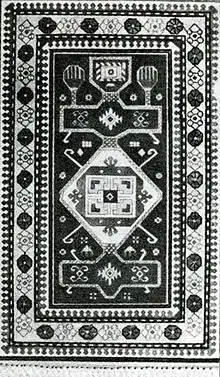
Dyeing wool
At dyeing workshops, professionals dye yarns with dye-stuffs mainly of plant origin, strictly following the centuries-old traditional techniques of colouring. To prepare the seven basic colors (red, green, yellow, black, dark blue, white, purple) and their tints used in carpet making, professional dyers use green walnut shells, the skin of pomegranates, indigo, leaves of the mulberry, quince and walnut plants, and roots of madder. In order to achieve yellow and its hues, they use bulb onion peels, mulberry leaves collected in the late autumn, etc. To produce red and pink colors, madder is used, and to obtain dark blue, blue and green, indigo dye is used. At the very end of the yarn dyeing process a dyer adds salt, alum or vinegar into the dye solution to increase the intensity, fastness and durability of colours. Then, dyed yarns are pressed and dried with special techniques.
Weaving
They are made using weaving looms, with average knot density (from 35õ60 to 55õ55). Three hand tools are used – a knife, a beater and shears.
Pulling
In most cases carpets manually woven of silk and wool have clear unevenness of their edges. To eliminate this characteristic, carpets are fastened to wooden floors with their four ends pulled. They are then raised up from the middle by means of special wooden lifters and smoothened on the reverse side. After that, the carpet is pulled and fastened to the wooden floor again and left in this position for two days. This process helps to straighten out the edges of the carpet.
Carpet-weaving schools
Quba-Shirvan schools of carpet weaving
The rise of the carpet art on the territory of Azerbaijan was undoubtedly related to a number of objective factors, among them the geographical location of this land, at the joint of the East and the West. The Greater Caucasus ridge, home to some Quba-Shirvan carpet-weaving schools, lies the borderline between Asia and Europe. Here is the historical juxtaposition point between the Islamic and Christian cultures. Long camelcades passed through this land in the Middle Ages.
Quba school of carpet weaving
The Quba school that includes the Gonagkend and Divichi districts covers up to 35 pattern compositions of the carpets. Quba is an historical region hosting a plenitude of various tribes. The region is populated by ethnic groups that speak different languages, among them Azerbaijanis, Lezghins, Tats, Budugs, Gyryzys and others. Quba carpets come with a wide variety of designs, which may differ even from village to village. The ornamental pattern is characterized by geometrical and vegetal motifs, most of them stylized. These include Gyryz, Gymyl, Gonakend, Shahnezerli and other carpets.
Shirvan school of carpet weaving
The Shirvan school is famous for its superb carpets. Shirvan is one of the most ancient historical regions of Azerbaijan. Carpet making of different types is a widespread craft with both settled and nomadic natives. The Shirvan school accounts for carpets manufactured in the following towns and villages of the Shirvan region: Shemaha, Maraza, Bijo, Gashad, Gagali, Archiman, Kurdamir. The school totals 25 compositions. The Salyan carpets, with similar artistic and technical features, also belong to this school. The Shirvan carpets are characterized by an intricate design, which depicts numerous artifacts of everyday life, birds and people.
Ganja-Kazakh school of carpet weaving
The carpets of this school are notable for peculiarity of their compositions and ornamental patterns. The Ganja carpets include a relatively small number of carpet compositions, all in all between 8 and 20 patterns. The Kazakh carpets cover about 16 compositions with various patterns. Kazakh, which is located on the NW of Azerbaijan, is the most famous carpet production region and also accounts for the Kazakh and Borchaly carpet groups. The Kazakh carpets have a geometrical ornamental pattern, the composition is not very complex with a focus on a schematic presentation of the geometrical patterns, plants and animals. The ornamental decor of the Ganja carpets is rich and diverse, with a focus on geometrical motifs as well as schematic presentation of plants and animals.
Baku school of carpet weaving
The Baku school of carpet weaving includes the villages of Novkhany, Fatmai, Nardaran, Bulbulya, Mardakan, Gaadi. These carpets are marked for their increased softness of the material and intense colors, as well as excellent artistic taste and exquisite decoration. This school has about 10 compositions. The historical sources and inscriptions on the carpets testify to the fact that carpet making was widely spread in these villages and carpet-ware was exported outside the country. The carpet composition often includes medallions. They are filled by various motifs, most often by stylized images of plants, which lost their resemblance to the original object after they had been geometrized.
Karabakh school of carpet weaving
The Karabakh carpets consist of 33 varieties. Due to the specifics of the local sheep wool, the Karabakh carpets are characterized by thick pile, high and fluffy. These carpets are marked for their vivid and joyous colors. They are divided into four groups: without medallions, with medallions, namazlyk and subject carpet. In the mountainous part of Karabakh, the carpets were made in Malybeili, Muradkhanly, Dashbulag, Jabrayil, and many other villages.
Carpets in social and economic life
Carpets are not used only as a home decor in Azerbaijan, they carry a great cultural significance as a family tradition transferred verbally and with practicing, and also associated with the daily life and customs of Azerbaijani people. Taking into account its socio-economic importance, Azerbaijani folk applied art, particularly carpet weaving has been the subject to the special attention of the government to preserve, study, promote and develop carpet weaving traditions of Azerbaijani people.[6][7] The Law “On the protection and development of carpet art of Azerbaijan” was adopted in December 2004,[8] "Azerkhalcha" was established in May 2016,[9] Carpet Weaver Day started to be celebrated on May 5th according to the Presidential Decree,[10] the new building for Azerbaijan Carpet Museum designed by an Austrian architect Franz Janz in the shape of a rolled carpet was constructed between 2007 and 2014.[11] In addition, the State Program on the “Protection and development of carpet art in the Republic of Azerbaijan 2018–2022” was approved in February 2018 by the President Ilham Aliyev with the aim to create raw material supply for this industry, improve the infrastructure for carpet-weaving, support the establishment of new workplaces, carry out qualified personnel training in the field of carpet-weaving, as well as, wool processing, wool and silk yarns manufacturing, processing plants used for dyeing and production of dyes.[7]
See also
References
- The traditional art of Azerbaijani carpet weaving in the Republic of Azerbaijan
- Azerbaijani carpet entered UNESCO List of Intangible Cultural Heritage
- "Azerbaijan-kilim". Archived from the original on 2016-01-15. Retrieved 2017-05-25.
- sumakh-carpets
- azerbaijani palas
- "UNESCO – Traditional art of Azerbaijani carpet weaving in the Republic of Azerbaijan". ich.unesco.org. Retrieved 2019-09-18.
- "On the approval of the State Program for the "Protection and development of carpet art in the Republic of Azerbaijan 2018–2022"". Ministry of Justice of Azerbaijan – Database of Regulatory Legal Acts. Retrieved 2019-09-18.
- "Law "On the protection and development of carpet art of Azerbaijan"". Ministry of Justice of Azerbaijan – Database of Regulatory Legal Acts. Retrieved 2019-09-18.
- "About Azerkhalcha". azerxalca.az. Retrieved 2019-09-18.
- "Azerbaijan celebrates Carpet Weaver Day | Vestnik Kavkaza". vestnikkavkaza.net. Retrieved 2019-09-18.
- "Azerbaijan National Carpet Museum". azcarpetmuseum.az. Retrieved 2019-09-18.
External links
| Wikimedia Commons has media related to Rugs and carpets of Azerbaijan. |
